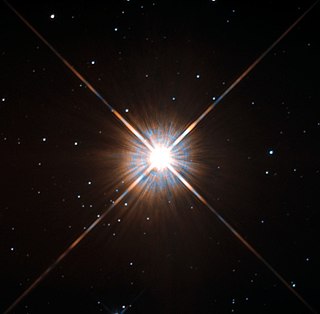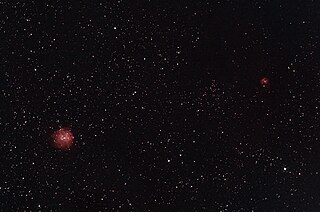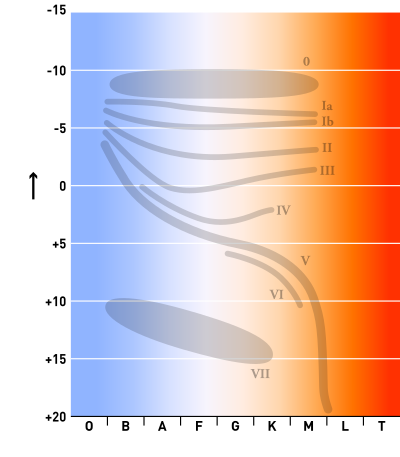
In astronomy, stellar classification is the classification of stars based on their spectral characteristics. Electromagnetic radiation from the star is analyzed by splitting it with a prism or diffraction grating into a spectrum exhibiting the rainbow of colors interspersed with spectral lines. Each line indicates a particular chemical element or molecule, with the line strength indicating the abundance of that element. The strengths of the different spectral lines vary mainly due to the temperature of the photosphere, although in some cases there are true abundance differences. The spectral class of a star is a short code primarily summarizing the ionization state, giving an objective measure of the photosphere's temperature.

A red dwarf is the smallest kind of star on the main sequence. Red dwarfs are by far the most common type of star in the Milky Way, at least in the neighborhood of the Sun. However, due to their low luminosity, individual red dwarfs cannot be easily observed. From Earth, not one star that fits the stricter definitions of a red dwarf is visible to the naked eye. Proxima Centauri, the star nearest to the Sun, is a red dwarf, as are fifty of the sixty nearest stars. According to some estimates, red dwarfs make up three-quarters of the stars in the Milky Way.

Supergiants are among the most massive and most luminous stars. Supergiant stars occupy the top region of the Hertzsprung–Russell diagram with absolute visual magnitudes between about −3 and −8. The temperature range of supergiant stars spans from about 3,400 K to over 20,000 K.

A blue supergiant (BSG) is a hot, luminous star, often referred to as an OB supergiant. They are usually considered to be those with luminosity class I and spectral class B9 or earlier, although sometimes A-class supergiants are also deemed blue supergiants.

A G-type main-sequence star, also often, and imprecisely, called a yellow dwarf, or G star, is a main-sequence star of spectral type G. Such a star has about 0.9 to 1.1 solar masses and an effective temperature between about 5,300 and 6,000 K. Like other main-sequence stars, a G-type main-sequence star converts the element hydrogen to helium in its core by means of nuclear fusion, but can also fuse helium when hydrogen runs out. The Sun, the star in the center of the Solar System to which the Earth is gravitationally bound, is an example of a G-type main-sequence star. Each second, the Sun fuses approximately 600 million tons of hydrogen into helium in a process known as the proton–proton chain, converting about 4 million tons of matter to energy. Besides the Sun, other well-known examples of G-type main-sequence stars include Alpha Centauri, Tau Ceti, and 51 Pegasi.

A giant star has a substantially larger radius and luminosity than a main-sequence star of the same surface temperature. They lie above the main sequence on the Hertzsprung–Russell diagram and correspond to luminosity classes II and III. The terms giant and dwarf were coined for stars of quite different luminosity despite similar temperature or spectral type by Ejnar Hertzsprung about 1905.

Iota Orionis is a multiple star system in the equatorial constellation of Orion the hunter. It is the eighth-brightest member of Orion with an apparent visual magnitude of 2.77 and also the brightest member of the asterism known as Orion's Sword. It is a member of the NGC 1980 open cluster. From parallax measurements, it is located at a distance of roughly 1,340 light-years from the Sun.

A subgiant is a star that is brighter than a normal main-sequence star of the same spectral class, but not as bright as giant stars. The term subgiant is applied both to a particular spectral luminosity class and to a stage in the evolution of a star.

A K-type main-sequence star, also referred to as a K-type dwarf, or orange dwarf, is a main-sequence (hydrogen-burning) star of spectral type K and luminosity class V. These stars are intermediate in size between red M-type main-sequence stars and yellow/white G-type main-sequence stars. They have masses between 0.6 and 0.9 times the mass of the Sun and surface temperatures between 3,900 and 5,300 K. These stars are of particular interest in the search for extraterrestrial life due to their stability and long lifespan. Many of these stars have not left the main sequence as their low masses mean they stay on the main sequence for up to 70 billion years, a length of time much larger than the time the universe has existed. Well-known examples include Alpha Centauri B and Epsilon Indi.

An F-type main-sequence star is a main-sequence, hydrogen-fusing star of spectral type F and luminosity class V. These stars have from 1.0 to 1.4 times the mass of the Sun and surface temperatures between 6,000 and 7,600 K.Tables VII and VIII. This temperature range gives the F-type stars a whitish hue when observed by the atmosphere. Because a main-sequence star is referred to as a dwarf star, this class of star may also be termed a yellow-white dwarf. Notable examples include Procyon A, Gamma Virginis A and B, and KIC 8462852.

An A-type main-sequence star or A dwarf star is a main-sequence star of spectral type A and luminosity class V (five). These stars have spectra defined by strong hydrogen Balmer absorption lines. They measure between 1.4 and 2.1 solar masses (M☉) and have surface temperatures between 7,600 and 10,000 K. Bright and nearby examples are Altair (A7), Sirius A (A1), and Vega (A0). A-type stars do not have convective zones and thus are not expected to harbor magnetic dynamos. As a consequence, because they do not have strong stellar winds, they lack a means to generate X-ray emissions.

A B-type main-sequence star is a main-sequence (hydrogen-burning) star of spectral type B and luminosity class V. These stars have from 2 to 16 times the mass of the Sun and surface temperatures between 10,000 and 30,000 K. B-type stars are extremely luminous and blue. Their spectra have strong neutral helium absorption lines, which are most prominent at the B2 subclass, and moderately strong hydrogen lines. Examples include Regulus, Algol A and Acrux

Pi3 Orionis (π3 Orionis, abbreviated Pi3 Ori, π3 Ori), also named Tabit, is a star in the equatorial constellation of Orion. At an apparent visual magnitude of 3.16, it is readily visible to the naked eye and is the brightest star in the lion's hide (or shield) that Orion is holding. As measured using the parallax technique, it is 26.32 light-years (8.07 parsecs) distant from the Sun.

Upsilon Orionis is a star in the constellation Orion. It has the traditional name Thabit or Tabit, a name shared with pi3 Orionis. It is a blue-white main sequence star of apparent magnitude 4.62 located over 3000 light-years distant from the Solar System. It is a suspected Beta Cephei variable.

Sigma Orionis or Sigma Ori is a multiple star system in the constellation Orion, consisting of the brightest members of a young open cluster. It is found at the eastern end of the belt, south west of Alnitak and west of the Horsehead Nebula which it partially illuminates. The combined brightness of the component stars is magnitude 3.80.

A yellow supergiant (YSG) is a star, generally of spectral type F or G, having a supergiant luminosity class. They are stars that have evolved away from the main sequence, expanding and becoming more luminous.

Theta2 Orionis is a multiple star system in the constellation Orion. It is a few arc minutes from its more famous neighbour the Trapezium Cluster, also known as θ1 Orionis.

An O-type star is a hot, blue-white star of spectral type O in the Yerkes classification system employed by astronomers. They have temperatures in excess of 30,000 kelvins (K). Stars of this type have strong absorption lines of ionised helium, strong lines of other ionised elements, and hydrogen and neutral helium lines weaker than spectral type B.
HD 93403 is a spectroscopic binary containing two highly luminous hot blue stars. It is 10,000 light years away in the Carina Nebula in the constellation Carina. It appears to have spectral type O5.5III, but this is composed of two spectra from a blue supergiant and blue main sequence star of spectral type O5.5I and O7V respectively. The two stars orbit every 15 days with a separation that varies from 93 R☉ to 149 R☉. The binary is shedding mass at the high rate of 0.0005 M☉ per year.

NGC 1624-2 is a massive O-type star located in the star cluster NGC 1624, in the constellation of Perseus, about 16,800 light years away. NGC 1624-2 is notable for being most strongly magnetised O-type star known, with a magnetic field strength of 20 kG, or about 20,000 times the Sun's magnetic field strength. It hosts a large and dense magnetosphere, formed from the interaction between its very strong magnetic field and its dense, radiatively-driven stellar wind, which also absorbs up to 95% of x-rays generated from around the star.














